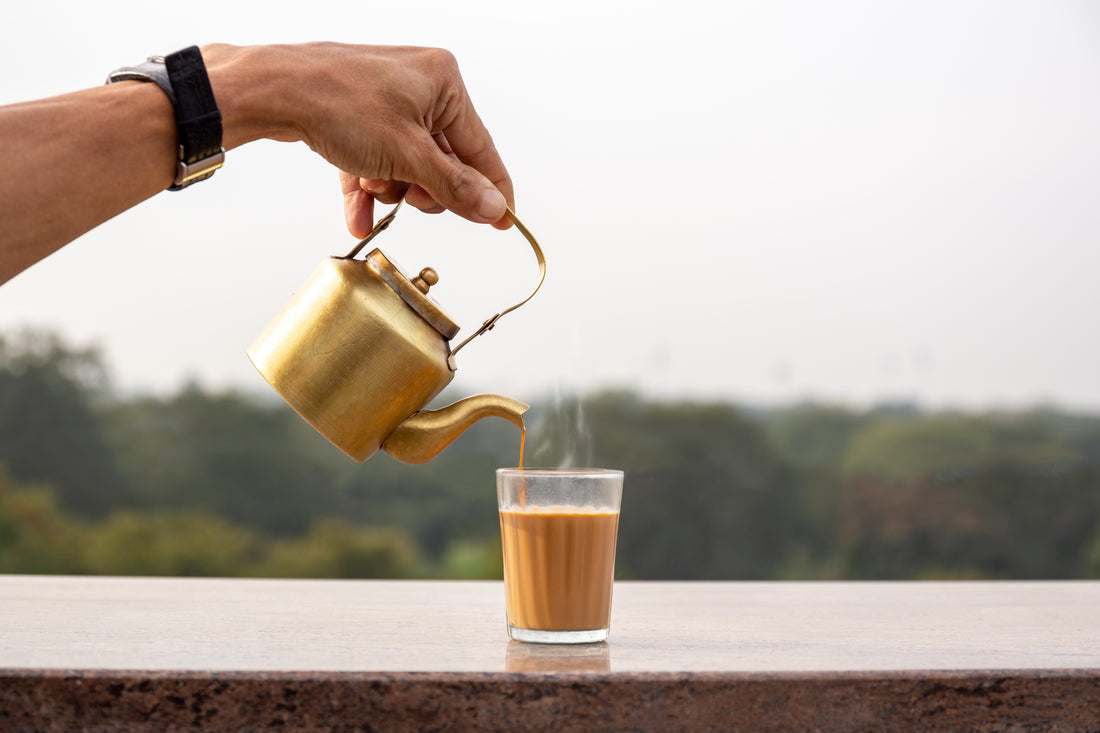When you're yearning for a flavorful and comforting sip, masala chai (literally "spiced tea") always seems to hit the spot.
You can easily find it in local cafés, coffee shops, or grocery stores, and yet there's so much more to this drink than meets the eye.
Its origins are intertwined with captivating tales of Ayurvedic traditions, loose-leaf tea, and colonialism. Join us on a spicy exploration as we unravel the story behind this fantastic beverage.
Ayurveda

Masala chai's journey began in the ancient traditions of Ayurveda, the holistic healing system that originated in India thousands of years ago. Ayurveda emphasized the use of spices for their medicinal properties, particularly to enhance digestion, boost immunity, and provide overall well-being.
Many of the spices used in Ayurvedic medicine - black pepper, ginger, cardamom, cinnamon, and nutmeg, to name a few - are the same spices used heavily in masala chai.
These beliefs laid the foundation for spices becoming a universal part of Indian cuisine, and eventually, they would find their way into the aromatic concoction of masala chai.
Tea
So, while Ayurveda added the spice, how did tea come into the picture?
We will write other posts about the various types of tea and its fascinating, drama-filled history - but let's look at a heavily truncated story for now.

Tea, originating from China thousands of years ago, had captured the attention of the world with its unique flavor and stimulating qualities. Fast forward to the 17th and 18th centuries, Western nations began to discover tea by way of traders, and in particular, the British royalty took a very strong liking to it.
However, given their enormous consumption of tea, they had concerns about China's monopoly on tea exports and began exploring how to produce it themselves in territories like India.
At first, they tried planting tea plants they smuggled from China, but this didn't work because of the difference in climate and terroir between China and India. But finally, in the middle of the 19th century, they discovered local, native tea plants growing in Assam, India.
Not even a century later, Assam and Darjeeling grew to be the powerhouses of tea exports that we know today, alongside Ceylon in Sri Lanka.
Birth of Masala Chai
Despite India becoming Britain's powerhouse in tea exports, tea held little meaning or value to the average Indian citizen at first.
In response, the British Indian Tea Association started promoting "tea breaks" to factories, textile mills, and mining companies in hopes their workers would ingrain tea drinking into their lives.
But the British were accustomed to consuming black tea with milk and sugar, while Indians had their own diverse range of spiced beverages. As the two cultures intertwined, masala chai emerged as a delightful fusion, combining the boldness of black tea with the vibrancy of Indian spices.
Independent chaiwalas (roughly translates to "tea seller/maker") started adding in spices and increasing the amounts of sugar and milk.

Furthermore, in an attempt to save money, chaiwalas would use the leftover tea leaves that didn't sell and boil everything together with the milk and spices. This created a more robust drink at a lower cost while catering to flavors Indian citizens were already familiar with.
And that was the birth of masala chai as we know it today.
With time, masala chai gained popularity not only within the Indian subcontinent but also beyond its borders. Its captivating aroma and tantalizing taste captured the hearts of tea enthusiasts worldwide. Today, you can find masala chai in various forms, from the traditional preparation on Indian streets to modern adaptations in trendy cafes.
You
And of course, it has likely made its way into your hands at one point or another.
So, the next time you savor a steaming cup of masala chai, take a moment to appreciate the rich context of history and flavors that culminate in this drink.
Let the comforting blend of spices and tea transport you to a world where tradition and innovation coexist, reminding us of the remarkable journey that chai has undertaken to become the beloved beverage it is today.
